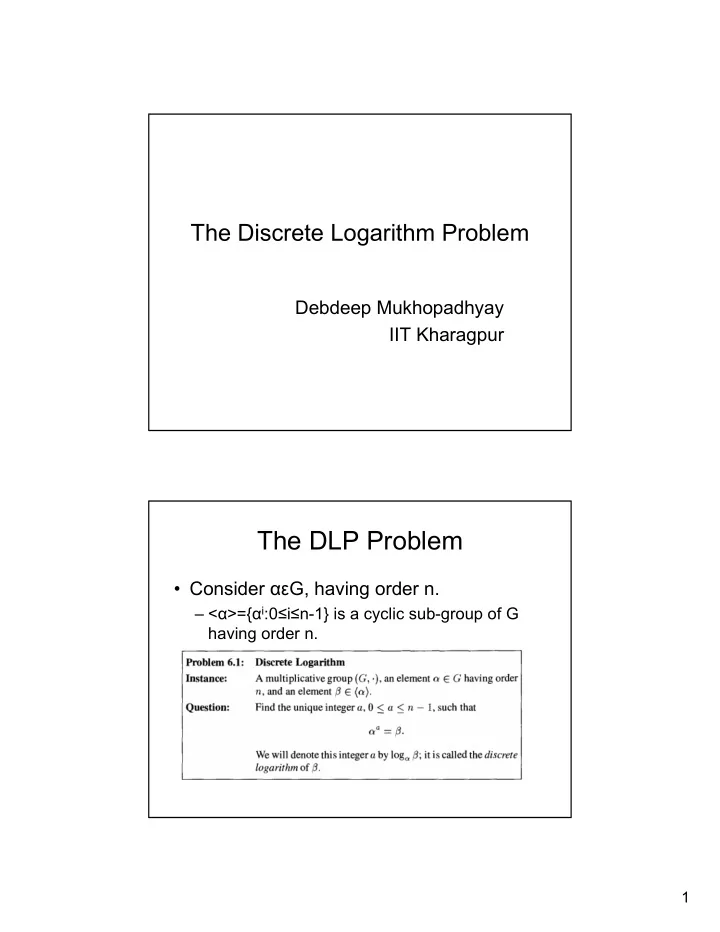

The Discrete Logarithm Problem Debdeep Mukhopadhyay IIT Kharagpur The DLP Problem • Consider αε G, having order n. – < α >={ α i :0 ≤ i ≤ n-1} is a cyclic sub-group of G having order n. 1
Cryptographic Utility of DLP • For suitable choices of the parameters, finding Discrete Logarithm seems to be difficult. • However, the inverse operation of exponentiation is efficiently computable by the square and multiply algorithm. – Exponentiation is a candidate one-way function. The ElGamal Cryptosystem 2
Working of the algorithm • Plaintext x is masked by multiplying it by β k , yielding y 2 . • The value α k is also transmitted as a part of the ciphertext. • Bob who has the secret ‘a’ can compute β k by raising α k to ‘a’. • Then he obtains x by dividing y 2 with β k • Note that for each plaintext, there are p-1 possible ciphertexts. Example • p=2579, α =2 (primitive element of Z p* ) • a=765 (secret value) • β =2 765 mod 2579=949. • Suppose, Alice wishes to send x=1299 to Bob. She randomly chooses k=853. – y 1 =2 853 mod 2579 = 435 – y 2 =1299(949 853 )mod 2579=2396 • Alice sends y=(435,2396) • Bob computes x=2396(435 765 ) -1 mod 2579=1299. 3
Algorithms for the DLP Problem • If α i was monotonically non decreasing with i, we could have done a binary search to find i. – but the problem with modular exponentiation is that there is no ordering of the powers. – Thus one have to do an exhaustive search in the worst case. • Thus it can be solved in O(n) time and O(1) space. – However pre-computation helps. Time Memory Trade Off • Suppose we store all possible values of α i (mod p) as ordered pairs (i, α i mod p) and sort the elements wrt the second parameter. Now search for the given challenge by employing binary search. • Complexity: Pre-computation O(n), Memory O(n), Time to sort: O(nlog n) [using a good sorting algorithm], Time to search O(log n) • Often we neglect the log n terms in these algorithms, as n is much larger than log n – thus Time to search O(1) and Pre-computation or Memory both are O(n) 4
Non-trivial Algorithms • Shank’s Algorithm • Pollard Rho Discrete Log Algorithm • Index Calculus Method Shanks Algorithm 5
Explanation • α mj =y= βα -i => α mj+i = β . • If βε < α >, log α β =(mj+i) mod n, where both 0 ≤ i,j ≤ m-1. – The search is successful as we can ensure that log α β≤ m(m-1)+(m-1)=n-1, as desired. – Complexity: O(m) Example • Compute, log 3 525 in Z 809 * . Note 809 is prime and 3 is a primitive element of Z 809 * . • Order=n=808, β =525, m= √ 808=29 • α 29 mod 809=99 6
Tables L1: • Match: (10,644) and (19,644) log 3 525=(29x10 +19)mod L2: 808=309. The Diffie Hellman Problem • DDH << P CDH << P DLP • Thus DDH hardness is the strongest assumption. 7
Application: The DH Key Agreement Scheme • Public: g and p • Secret: Alice’s exponent a, Bob’s exponent b g a mod p g b mod p Alice, a Bob, b • Alice computes (g b ) a = g ba = g ab mod p • Bob computes (g a ) b = g ab mod p • Could use K = g ab mod p as symmetric key Application: The DH Key Agreement Scheme • Subject to man-in-the-middle (MiM) attack g a mod p g t mod p g t mod p g b mod p Alice, a Trudy, t Bob, b • Trudy shares secret g at mod p with Alice • Trudy shares secret g bt mod p with Bob • Alice and Bob don’t know Trudy exists! 8
Designing Cryptographic Protocols • The Man in the Middle Attack on the DH key agreement scheme shows that although the primitives are strong, the protocol can be weak. • Thus, the next question is how to design strong protocols from strong primitives. • We will not discuss in depth, but have a brief overview as our last topic this semester… Possible Preventions • How to prevent MiM attack? – Encrypt DH exchange with symmetric key – Encrypt DH exchange with public key – Sign DH values with private key – May be other methods also exist 9
Recommend
More recommend